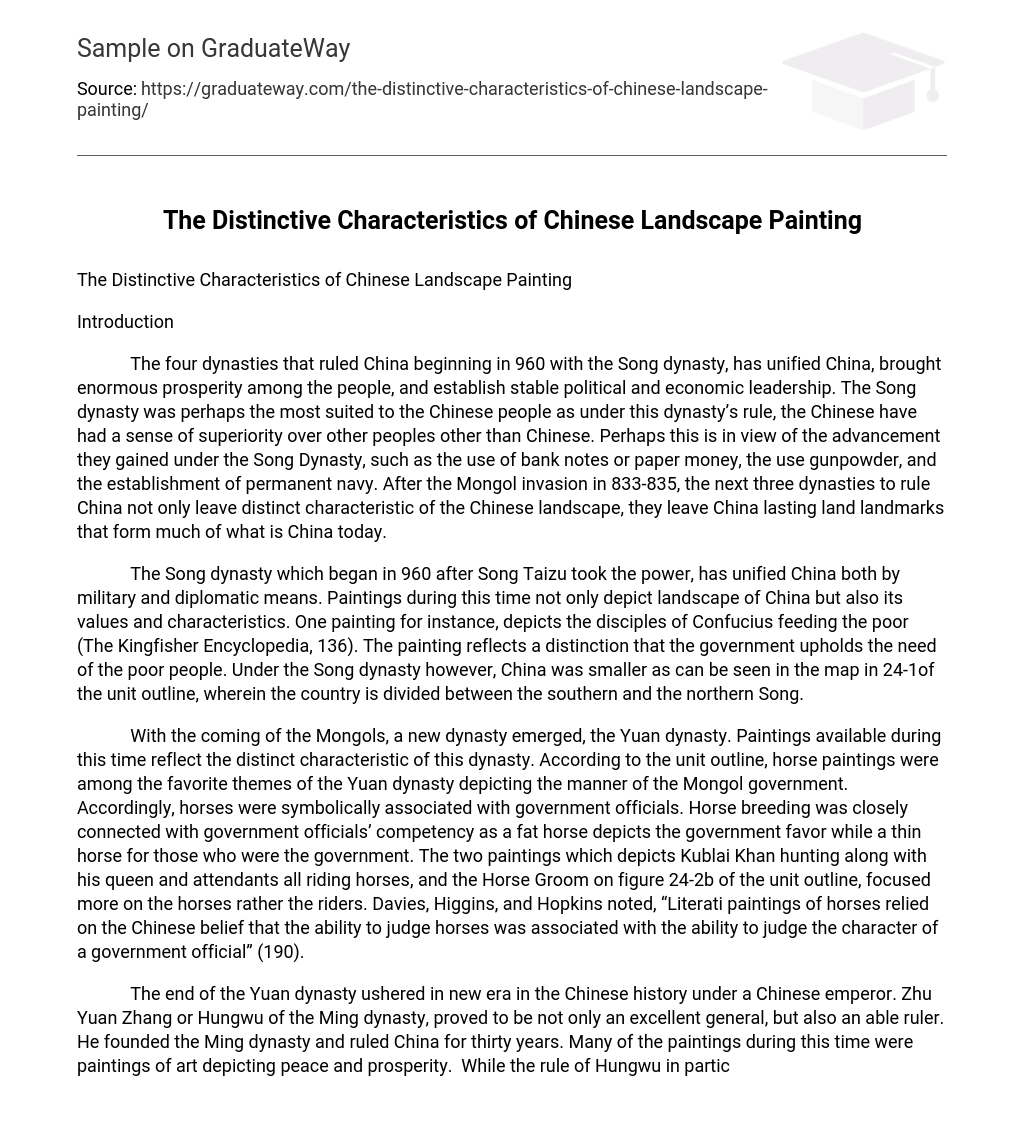Introduction
The four dynasties that ruled China beginning in 960 with the Song dynasty, has unified China, brought enormous prosperity among the people, and establish stable political and economic leadership. The Song dynasty was perhaps the most suited to the Chinese people as under this dynasty’s rule, the Chinese have had a sense of superiority over other peoples other than Chinese. Perhaps this is in view of the advancement they gained under the Song Dynasty, such as the use of bank notes or paper money, the use gunpowder, and the establishment of permanent navy. After the Mongol invasion in 833-835, the next three dynasties to rule China not only leave distinct characteristic of the Chinese landscape, they leave China lasting land landmarks that form much of what is China today.
The Song dynasty which began in 960 after Song Taizu took the power, has unified China both by military and diplomatic means. Paintings during this time not only depict landscape of China but also its values and characteristics. One painting for instance, depicts the disciples of Confucius feeding the poor (The Kingfisher Encyclopedia, 136). The painting reflects a distinction that the government upholds the need of the poor people. Under the Song dynasty however, China was smaller as can be seen in the map in 24-1of the unit outline, wherein the country is divided between the southern and the northern Song.
With the coming of the Mongols, a new dynasty emerged, the Yuan dynasty. Paintings available during this time reflect the distinct characteristic of this dynasty. According to the unit outline, horse paintings were among the favorite themes of the Yuan dynasty depicting the manner of the Mongol government. Accordingly, horses were symbolically associated with government officials. Horse breeding was closely connected with government officials’ competency as a fat horse depicts the government favor while a thin horse for those who were the government. The two paintings which depicts Kublai Khan hunting along with his queen and attendants all riding horses, and the Horse Groom on figure 24-2b of the unit outline, focused more on the horses rather the riders. Davies, Higgins, and Hopkins noted, “Literati paintings of horses relied on the Chinese belief that the ability to judge horses was associated with the ability to judge the character of a government official” (190).
The end of the Yuan dynasty ushered in new era in the Chinese history under a Chinese emperor. Zhu Yuan Zhang or Hungwu of the Ming dynasty, proved to be not only an excellent general, but also an able ruler. He founded the Ming dynasty and ruled China for thirty years. Many of the paintings during this time were paintings of art depicting peace and prosperity. While the rule of Hungwu in particular was ruthless, as depicted in the painting in Figure 24-4b in the unit outline, it also depict lavish lifestyle and cruelty of the emperor. Generally however, as most of the paintings during this time were concern on art, the Ming dynasty was characterized by peace and relative prosperity that had also dwindled later due to a series problems and corruptions in the bureaucracy.
With the collapsed of the Ming dynasty, the Qing dynasty ascended to the imperial power. Founded by the Manchus or the people who lived in Manchuria, this dynasty brought enormous wealth and prosperity to the Chinese people as depicted in the painting about a woman weaving silk and the great village (Kingfisher, 263). The paintings of the Qing dynasty depict economic advancement and the growth of the silk industry. Overall, The Qing dynasty has brought wealth and prosperity as depicted by various paintings, more than all the other three dynasties.
Conclusion
There is no doubt that China is great nation today. They weathered more than a thousand years of struggles, war, corruption and disintegration. The centuries of rule of the different dynasties certainly have uniquely contributed to what China has become today. With their various styles of governance, of focus in governing, and of various developments they have initiated, China not only became a well developed country, it became a unified but multi-ethnic country.
Work Cited
Davies, Stephen; Higgins, Kathleen Marie; & Hopkins, Robert A Companion to Aesthetics, Volume 3 Singapore: John Wiley & Sons, 2009
The Kingfisher History Encyclopedia China: Oxford University Press, 2004





